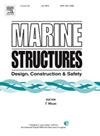DNV-RP-C203修订海底连接器疲劳分析方法的背景
IF 4
2区 工程技术
Q1 ENGINEERING, CIVIL
引用次数: 0
摘要
本文介绍了DNV推荐规范DNV- rp - c203 2024版中对钢锻件疲劳分析程序和设计S-N曲线的修改建议。该程序专门针对海底工业中使用的低合金锻件,并结合了材料强度、表面粗糙度、平均应力、缺口效应和使用环境等重要因素。自2016年该程序最初引入以来,各种实验室测试项目的额外数据的可用性允许对该方法进行重新评估和改进。行业多年来的实践经验也在其发展中发挥了至关重要的作用,突出了建立一致方法的挑战,该方法涵盖了应力范围、平均应力水平和缺口半径的不同组合。2024年版推荐实践的主要变化包括改进缺口模型和修订具有阴极保护的海水环境的S-N曲线。这些改进旨在提供更准确的疲劳分析结果。此外,本文还介绍了基于推荐规范的疲劳分析过程的实例,重点介绍了具有不同缺口半径的简单缺口试件。尽管这些样品可能与海底连接器系统不直接相似,但它们的分析可以帮助用户校准他们自己的疲劳分析。本文章由计算机程序翻译,如有差异,请以英文原文为准。
Background for revised fatigue analysis methodology of subsea connectors in DNV-RP-C203
This paper presents the proposed changes to the fatigue analysis procedure and design S-N curves for steel forgings in the 2024 edition of the DNV recommended practice DNV-RP-C203. The procedure specifically targets low alloy forgings used in the subsea industry and incorporates important factors such as material strength, surface roughness, mean stress, notch effect, and in-service environment. The availability of additional data from various laboratory test projects since the procedure's initial introduction in 2016 has allowed for a reassessment and improvement of the methodology. Practical experiences gained from several years of use by the industry have also played a crucial role in its development, highlighting the challenge of establishing a consistent methodology that covers different combinations of stress range, mean stress level, and notch radii. The key changes made in the 2024 edition of the recommended practice include improvements in the notch model and revisions to the S-N curves for seawater environment with cathodic protection. These enhancements aim to provide more accurate fatigue analysis results. Additionally, the paper presents practical examples of the fatigue analysis process based on the recommended practice, focusing on simple notched specimens with varying notch radii. Although these specimens may not directly resemble subsea connector systems, their analysis serves to assist users of the recommended practice in calibrating their own fatigue analyses.
求助全文
通过发布文献求助,成功后即可免费获取论文全文。
去求助
来源期刊

Marine Structures
工程技术-工程:海洋
CiteScore
8.70
自引率
7.70%
发文量
157
审稿时长
6.4 months
期刊介绍:
This journal aims to provide a medium for presentation and discussion of the latest developments in research, design, fabrication and in-service experience relating to marine structures, i.e., all structures of steel, concrete, light alloy or composite construction having an interface with the sea, including ships, fixed and mobile offshore platforms, submarine and submersibles, pipelines, subsea systems for shallow and deep ocean operations and coastal structures such as piers.
 求助内容:
求助内容: 应助结果提醒方式:
应助结果提醒方式:


